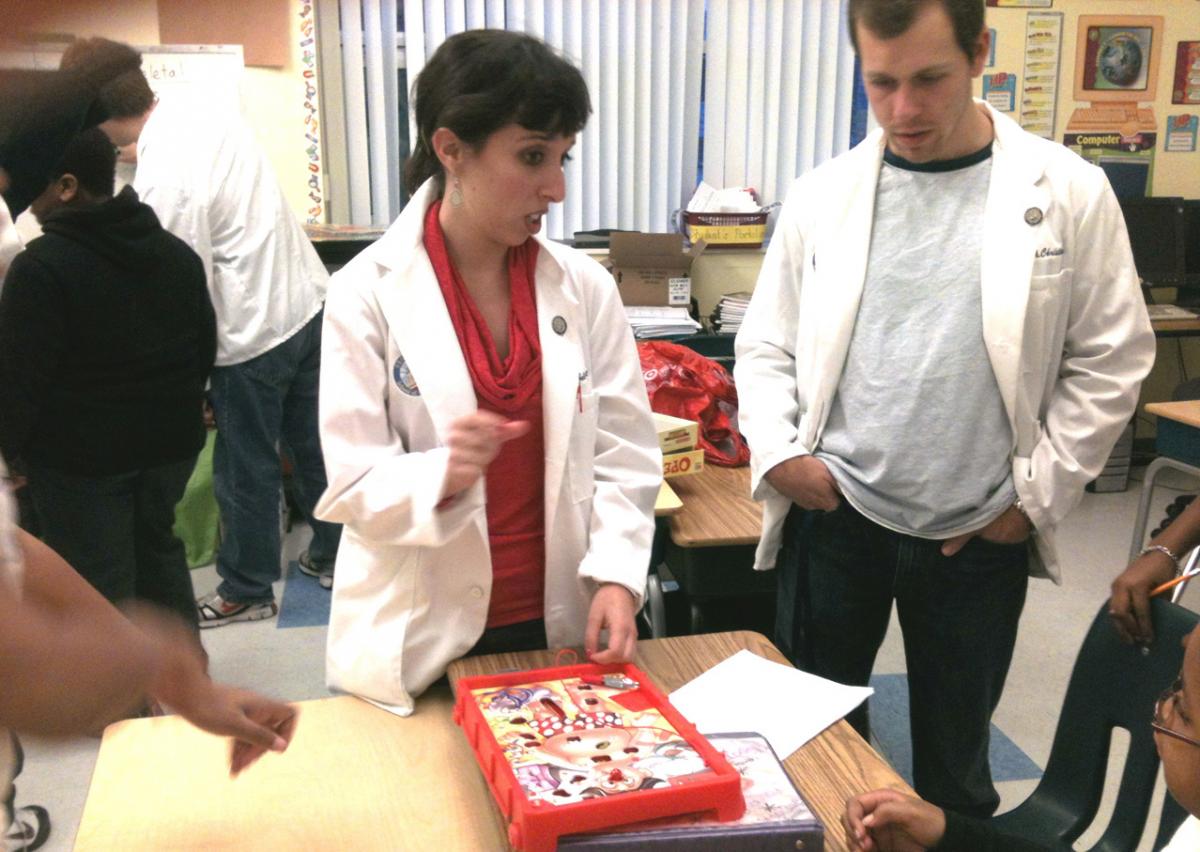Service-Learning: A Course Benefiting Students and Faculty Team Leaders

Posted in GUMC Stories
In 1995, the School of Medicine developed and implemented a program of service-learning to provide medical and nursing students with the knowledge and skills to advance community health priorities.
Now, service-learning is an individual module within the doctoring curriculum required for all first year medical students.
Faculty team leaders are key to course’s success. As new team leaders are being recruited for the 2012 fall semester, we asked the course director, Dr. Donna Cameron, how a program designed to help students can also benefit the faculty team leader.
Q. What are the objectives of the service-learning module?
Service-Learning is a method of experiential learning where students meet community health needs while developing their own ability to understand and address the complex health challenges they will encounter in patient care. We believe that faculty team leaders can help service-learning students to grow in four areas. First, we want students to learn to independently reflect upon their community sites and participants, self-correcting where necessary to improve their interactions and contributions. Secondly, we want students to realize that the health status of the community participants at their site is affected and shaped by many complex systems. We also want students to critically observe and describe the multiple systems at work. Finally, as a team of consultants, we want students to collaborate with the community partner to create a deliverable that meets the needs of their community site. Informed faculty leaders can guide students in developing the skills and attitudes that can help students achieve these objectives.
Q. With nearly 200 first-year medical students, how is this community-based learning coordinated?
We’ve required service-learning for a while now and have developed an efficient system that allows students to choose an area of interest. First, we recruit community participants to partner with the medical school faculty and students. Students self-enroll in the community site of interest to them, based on brief online descriptions of each community site. In the meantime, we recruit faculty leaders and offer in-person and online training. Then the true collaboration begins. Community partners, faculty and students collaborate to decide on a deliverable product, service or other need to address. Then they spend the semester addressing that need. Students present their deliverable at a grand finale event on January 29, 2013.
Q. What is the role of the faculty team leader?
 There are two types of team leaders: faculty team leaders, and consultant team leaders.
There are two types of team leaders: faculty team leaders, and consultant team leaders.
Faculty team leaders mentor and coach students, pointing them to appropriate resources for creating the deliverable for the community site. The faculty team leader also serves as the link between the community partner and the student team.
Consultant team leaders’ primary role is to provide site-specific expertise and advice much like consultants, to the student team.
Q. What are the responsibilities of the faculty team leader and what is the time commitment?
Faculty team leader responsibilities include: 1) supervising and evaluating the students’ program planning, teamwork, and professionalism; 2) participating in the community project to model the health professional’s role in community settings; 3) leading small group discussions and training sessions with students.
The time commitment for the faculty team leader is approximately 20 hours between September 2012 and January 2013, i.e., attendance at a training session, attendance and debriefing after each session in the community, and attendance at the grand finale event.
Consultant team leader responsibilities include: 1) sharing expert advice about the community site, community participants and/or creation of the deliverable; 2) mentoring/guiding the team in creating the deliverable; 3) attending at least three sessions (1, 3 or 4, and final session); 4) being available to the team on an as-needed basis.
The time commitment for the consultant team leader is approximately 12 to 14 hours between September 2012 and January 2013, i.e., attendance at a training session, monitoring and participating in online conversations about the students’ interactions with each other and the community participants, offering expert advice as needed, and attendance at the grand finale event.
Q. What is some of the feedback received from previous faculty team leaders?
One of our physician faculty team leaders told me she met a community participant at a transitional shelter for women with mental health and substance abuse challenges. Two years later, as the physician was waiting for the elevator in the hospital, someone spoke to her by name. It was the community participant, now a hospital employee! She couldn’t help but wonder if the service learning activity at the shelter might have positively impacted this woman. What a success story!
Q. Is it too late for faculty members to participate this fall?
No, in fact the training session for faculty team leaders is Wednesday, August 22 from 9:30 to noon. To sign up or get more information, please contact the course coordinator Jessica Lee at jhl223@georgetown.edu or 202-687-0925. If faculty members are interested in speaking to previous team leaders, we’ll gladly put them in touch with someone.
For more information about the service-learning module, visit: http://familymedicine.georgetown.edu/Service-Learning
Q. Who are some of the team leaders that could offer insight for faculty members considering participation?
If faculty members are interested in being team leaders and they are interested in speaking to previous team leaders, consider talking to Dr. Irene Jillson, Dr. Kim Bullock, Ms. Marisa Brown, Sister Mary Louise Wessell, Dr. Beverly Jackson, or Ms. Wendy Jones.
By Karen Mallet, GUMC Communications
